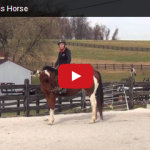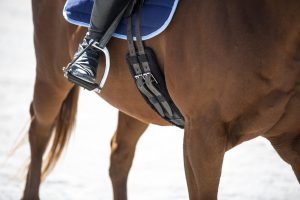This week’s blog topic is about riding a nervous horse and stopping a horse who doesn’t want to stop. I say this in the video, but I will say it here as well – I typically don’t continue riding a horse that is continually nervous and not stopping when I ask. Personally, I find it much easier to work through these types of problems from the ground and then get back in the saddle. A nervous, jittery horse is not in a good state of mind for learning, so your time spent training when they are in this state can be a waste.
However, I have gotten a few questions on this topic, so I wanted to give you some tips on what I do when I feel a horse tensing up under me or when they won’t stop when I ask with my seat.














7 Responses
Hi Callie
Wonderful video as always. Great reminders for all of us who have been riding a long time and tend to need refreshers.
I was thinking that it would be great for you to give lessons geared to different levels of riders or even different disciplines. You have such a common sense approach to riding and so easy to understand.
Thanks for the suggestion, Teresa!
Hi Callie
I’ve just discovered your blog and it’s really helpful- thank you. Do you have any tips for a horse that naps when out on hacks? I’ve just started loaning a horse 3 days a week and she is bit of a challenge! http://www.anoutdoorlifestyleblog.com Harriet xx
Hi Harriet,
Thanks for your comment and I am glad you are enjoying the blog! I wasn’t sure what “napping” meant, so I watched the video on your blog and I assume you mean where the horse is rearing and then going sideways? Basically the horse in that video needs to relax and get more fluid movement forward. I would start this on the ground, getting the horse’s head lowered and the horse moving forward freely whenever asked. Then I would work on teaching the horse to soften and relax into bit pressure, intead of fighting it like the horse in that video is doing. In the video it appears that the horse is spooking at something at the end of the arena, so the rider is taking them towards it again and again only to have the horse run away every time. All this does is make the horse even more likely to do it the next time. Since this horse is already so stiff and tense, I would get off and work through the issue at the “safe” end of the ring from the ground until the horse is once again willing and relaxed. I hope this answer helps you – there are many things that can factor into this – for example the horse in the video also has a leverage bit in, which only means more pressure on an already stiff horse. This can start to cause the feet getting stuck and the rearing. So I know it wasn’t your horse in the video, but I hope these observations still help! Callie
Hi Callie! I love your videos, even though I am fairly new to this sport and dont have my own horse yet, many things are very useful and I’m taking notes for when I get my own horse.
My question is on regards to a comment you made at the beginning of the video, you said your were asking her to bend a little. What do you mean by that?
Also I have a request. You see, I ride a loan mare that is ridden by many riders, with many levels and types of riding. So she is a bit spoiled and “slick”, if you know what I mean. Could you do a video on how to best handle this type of horses?
Finally, I am curious about something else – Before riding a horse, can I do something to sort of prepare him for me? like talk to him, or pamper him somehow? Since mine is a loan, I dont have access to brush him and saddle her, so I am wondering if you have any suggestions on how to “connect” with this type of horse and create a good relationship with her.
Thanks so much for all your help.
Hi Gaby,
Bending means putting a curve in a horse’s body or neck. It is often used to improve the horse’s balance, supple their muscles, or turn their attention away from something that may be distracting them.
Can you tell me a bit more what you mean by spoiled and slick? Slick is actually a term I have never heard used before! What types of things does the horse you ride do?
If you don’t have access to spend time with the horse you ride outside of “work” time (riding, etc), then I believe being as fair as consistent as you possibly can with your requests, releases, and rewards will have the biggest impact on your relationship with this horse.
Hi Callie
Thanks for your answer.
By slick I meant tricky, very ready to take advantage of a beginner rider like me and not follow its cues – I guess that since they receive many different signs and cues from many different level riders, they dont have a clear response to any of them. For example, sometimes when I ask my mare to canter, she will trot for the middle of the paddock. Others, she will shake her head or even kick a little with her hind legs. My trainer keeps telling me to hit her with the riding crop, once and hard on her rump, or to pull her really hard to bring her back to the border of the paddock, but I dont feel comfortable doing that. Also, sometimes my trainer tells me to use more leg than crop, but it has been very hard for me to “use” the leg while trotting, and there are great days where I ride as if I know how to, and other days where nothing seems to go they way I want. So I get very confused because I dont know if its just me not giving the right signs, or if its the mare that is not in the mood and just wont do what its told.
All your horses seem so well educated and tame, that I wonder what to do with a “tricky” one…
Gaby